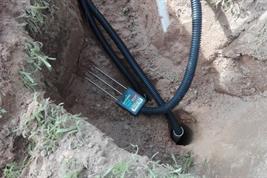21.06.2024

A team of scientists from the Leibniz Centre for Agricultural Landscape Research (ZALF), the Institute of Technology and Resource Management in the Tropics and Subtropics (ITT) at Cologne University of Applied Sciences, the Institute of Environmental Sciences and Geography at the University of Potsdam and the Institute of Crop Science and Resource Conservation (INRES) at the University of Bonn have conducted a study with the help of modern, digital sensors to investigate the influence of plants and soils on soil moisture. The method presented in the study can contribute to a better understanding of the factors influencing soil moisture in further research. This is important for the development of more water-efficient cultivation methods. The results have now been published in the journal "Hydrology and Earth System Sciences".
IIn the study, the researchers analyzed 64 soil moisture time series from a diversified field with seven different crops and two weed management strategies. The results showed that about 97% of the spatial and temporal variation in soil moisture can be explained by five main components. Weather-related factors explained 72.3 %. 17.0 % were attributed to the different seasonal behavior of the crops. Soil texture was responsible for 4.1 % and the cultivation system for only 2.2 % of the deviations. The soil depth of the measurement only had an influence of 1.7%. This means that 19.2 % of the changes in soil moisture can be explained by plant-related factors. Only 5.8% can be attributed to soil properties.
To the researchers' surprise, neither the topography of the terrain nor the weed control strategy had a significant influence. Soil and root heterogeneity were also negligible, according to the authors. Although the results are highly site-dependent, the approach for the statistical evaluation of time series presented can be applied to a wide range of conditions.
LoRaWAN-based sensor networks
Within the study, the researchers used so-called LoRaWAN-based wireless sensor networks, an advanced technology for wireless monitoring of soil moisture. These networks enable the transmission of data over long distances with low energy consumption. Sensors in the soil continuously measure the moisture at different depths and send the data to central databases in real time. This enables accurate and continuous monitoring of soil conditions.
The patchCROP landscape experiment
The investigations took place as part of the patchCROP landscape experiment in Tempelberg, Brandenburg. The experiment investigates the effects of spatial and temporal diversification in cultivation on soil health, water availability, yield, biodiversity and the use of pesticides.
"Our research shows how important it is to understand the interactions between soil conditions and plant species in order to better understand soil moisture," explains Kathrin Grahmann, one of the lead researchers on the study. "With the help of modern sensor technology, we will be able to develop sustainable agricultural practices in the future to further optimize water use."
Project partner:
- Leibniz Center for Agricultural Landscape Research (ZALF)
- TH Cologne
- University of Potsdam
- University of Bonn
Funding:
This research work was funded by the German Research Foundation (DFG) as part of the German Excellence Strategy (EXC 2070: PhenoRob; project number 390732324).
